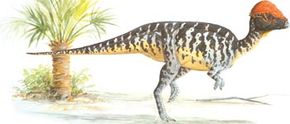Quck answer
Prenocephale is a genus of small, herbivorous dinosaur from the Late Cretaceous period. It belonged to the family Pachycephalosauridae, known for their thickened skulls and dome-shaped heads. Prenocephale had a small, rounded skull with a thickened area at the top, but it lacked the distinctive dome shape seen in other pachycephalosaurs. It was also smaller than many of its relatives, only reaching up to 2 meters in length. Prenocephale likely used its thickened skull for head-butting during intraspecific competition, but its exact behavior and lifestyle are still unclear due to the limited fossil record.
Extinct Animals

Prenocephale prenes. View more dinosaur images.
Brian Franczak
Prenocephale, pronounced PREN-oh-cee-FAL-EE, lived during the Late Cretaceous period and belonged to the family Pachycephalosauridae of the suborder Marginocephalia, within the order Ornithischia. Its fossils were discovered in Mongolia, Asia and they are among the best-preserved dinosaur materials ever found. The Joint Polish-Mongolian Expeditions to the Gobi Desert yielded an almost complete skull and most of the skeleton of the animal, which was named and described in 1974.
The name Prenocephale means “sloping head” and refers to the large domed skull roof that was high and rounded where it covered the braincase. The dome was so large that it extended back to the stout shelf at the back of the skull. The skull was reinforced and tightly joined with many rounded bumps and ridges of bone on the surface of its dome, face, and cheek.
With its large eye sockets, Prenocephale may have had excellent eyesight and was a herbivore that fed on soft leaves or fruits. It probably also ate insects, if it could catch them. Like its relatives Stegoceras and Pachycephalosaurus, Prenocephale may have used its dome for head-butting contests, which the thick skull roof would have protected from damage during head-on collisions.
Prenocephale was 6.5 feet (2 meters) in length and lived in the Late Cretaceous period in Asia’s Mongolia.
Dinosaur Image Gallery
FAQ
1. What is Prenocephale?
Prenocephale is a genus of herbivorous dinosaur that lived during the Late Cretaceous period, about 95 million years ago. It was a small dinosaur, measuring about 2 meters in length and weighing around 30 kilograms. Prenocephale belonged to a group of dinosaurs called pachycephalosaurs, which were characterized by their thick, domed skulls.
2. What did Prenocephale eat?
Prenocephale was a herbivore, which means it only ate plants. Based on its teeth, scientists believe that it may have fed on tough, fibrous vegetation such as ferns and cycads. Its small size may have allowed it to access vegetation that was too small for larger herbivores to reach.
3. How did Prenocephale defend itself?
Like other pachycephalosaurs, Prenocephale had a thick, domed skull that was used for head-butting. It is believed that males used their skulls to compete for mates or territory, while also defending themselves against predators. However, it is still unclear how effective this method of defense was against larger predators such as tyrannosaurs.
4. Where have Prenocephale fossils been found?
Fossils of Prenocephale have been found in Asia, specifically in Mongolia and China. The first Prenocephale fossil was discovered in 1948 by a joint Soviet-Mongolian expedition in the Gobi Desert.
5. What is the significance of Prenocephale?
Prenocephale is significant because it is one of the best-known pachycephalosaurs, with many well-preserved fossils. Its thick, domed skull has also made it an interesting subject for research into dinosaur behavior and biomechanics. Additionally, Prenocephale and other pachycephalosaurs provide important insight into the evolution of dinosaurs and how they adapted to their environments.





Leave a Reply